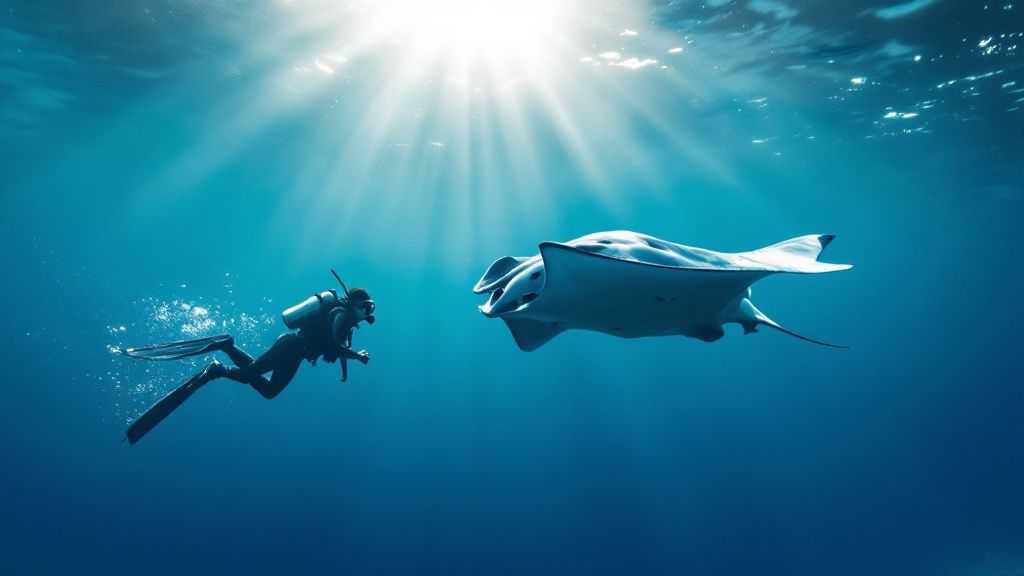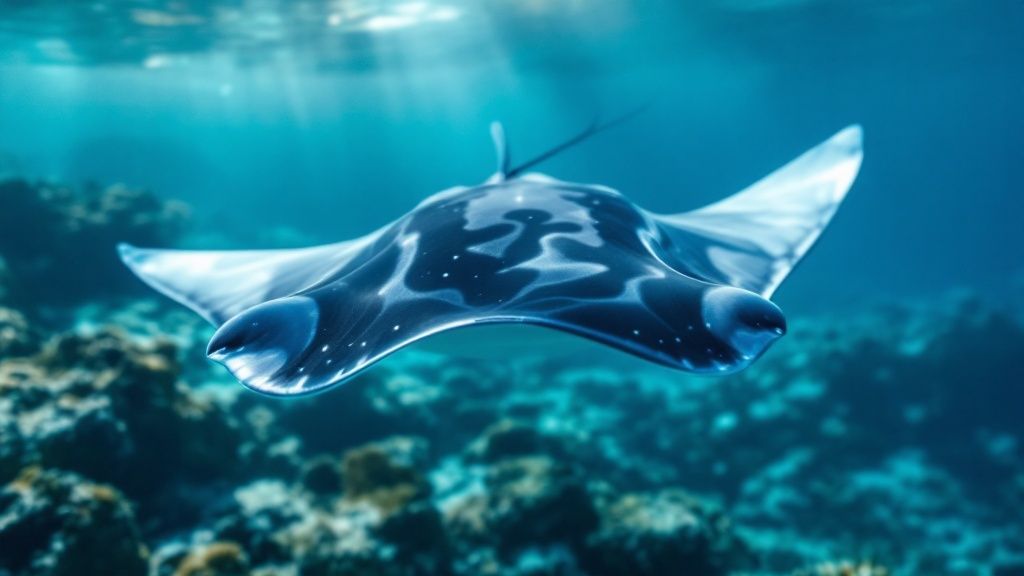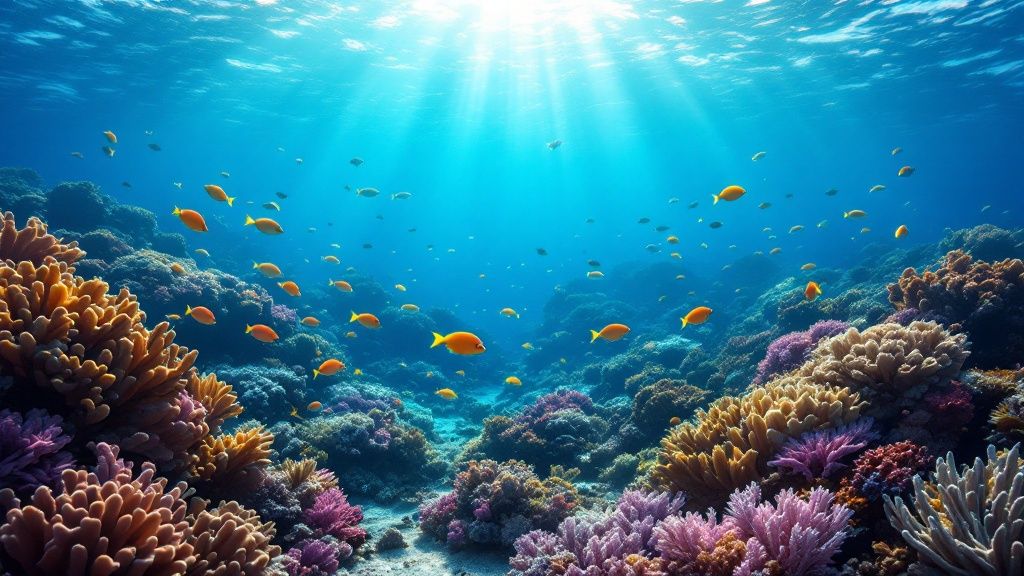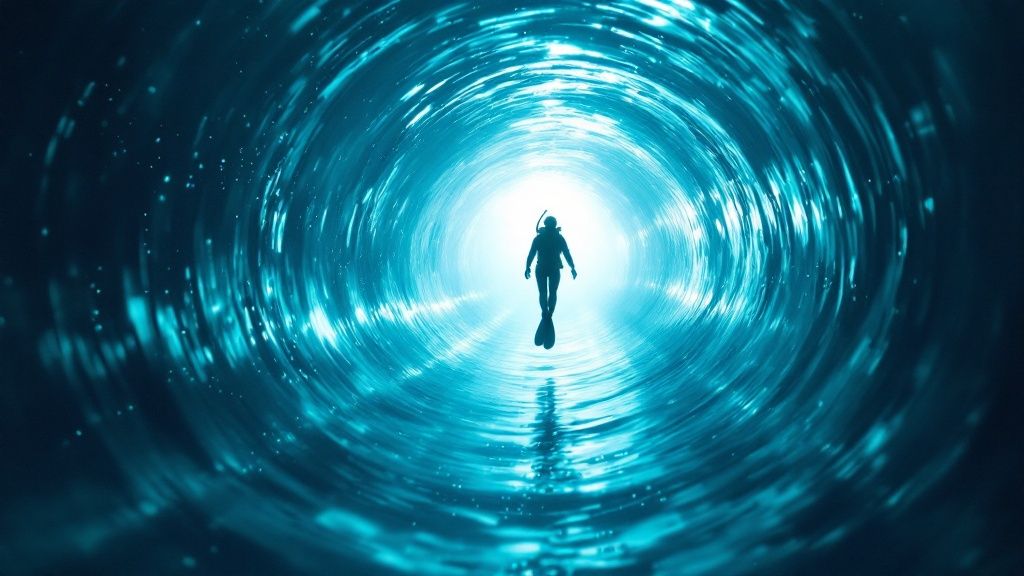Why Kona Manta Dives Create Life-Changing Encounters
Kona, Hawaii, isn't just a beautiful island destination; it's a world-renowned hotspot for manta ray encounters. A special combination of environmental factors makes this area a haven for these gentle giants, turning a regular dive into an unforgettable experience. Nutrient-rich currents, protected bays, and consistent plankton blooms are the basis of this "manta magic." This unique mix provides an abundant food supply, attracting mantas and creating a thriving underwater ecosystem. These perfect conditions contribute to Kona's reputation as a top manta ray destination. This isn't just a quick glimpse; it's a deep dive into a world few have the chance to see.

The Magic of Predictable Encounters
One of the most amazing things about diving with manta rays in Kona is the high likelihood of an encounter. Unlike many wildlife experiences that depend on luck, Kona offers almost guaranteed sightings. Manta rays show strong site fidelity, coming back to the same feeding areas night after night. This predictable pattern comes from the consistent availability of plankton, their main food source. Manta ray sightings along the Kona Coast are remarkably regular, making it a prime spot for those wanting to see them. Kona Honu Divers report manta ray sightings on over 80% of night dives at popular locations like 'Manta Ray Heaven' and 'Garden Eel Cove'. This high success rate is thanks to the nutrient-rich waters and unique underwater landscape. Manta rays are smart, curious animals, often interacting with divers and creating an unforgettable experience. Their ability to recognize and engage with divers they've seen before adds to Kona's allure. The region’s responsible tourism practices ensure these encounters are respectful and sustainable for generations to come. This consistency lets divers plan their experience with confidence, knowing they have a high chance of observing these majestic creatures in their natural home.
The Transformative Power of Connection
If you're considering your first encounter, a guided dive is a great option. An experienced guide can enhance your manta ray swim Kona Hawaii adventure. The impact of a Kona manta dive goes far beyond a simple sightseeing excursion. These encounters are often described as profoundly moving and even spiritual. The sheer size and grace of these animals, combined with their gentle nature, inspire a sense of awe and wonder. Imagine yourself floating in the dark ocean, surrounded by these graceful giants as they perform their captivating feeding dances. This close interaction creates a deep connection with the ocean, often inspiring a new appreciation for marine conservation.
A Legacy of Respect and Sustainability
The Kona community is dedicated to responsible tourism. Local dive operators prioritize the well-being of the manta rays, following strict guidelines to minimize disruption and maximize respect. This careful approach ensures the long-term health of the manta ray population and the ocean environment. This commitment to sustainability protects this unique experience for future generations. It’s not just a dive; it's a contribution to preserving these incredible animals and their habitat. This mindful approach makes the Kona manta dive a genuinely unique and enriching experience.
Kona's Premier Manta Ray Dive Sites: Beyond the Obvious

Kona, Hawaii, is renowned for its incredible manta ray dives. But not all dive sites are equal. This guide, informed by local experts at Kona Honu Divers, goes beyond the usual tourist brochures to reveal some hidden gems and key differences between Kona's manta ray dive locations. You'll be ready to choose the perfect spot for an unforgettable underwater encounter.
Unveiling Kona's Hidden Manta Hotspots
Popular sites like Manta Ray Heaven and Garden Eel Cove draw crowds for their reliably spectacular sightings. Understanding the nuances of each site, however, can significantly enhance your dive. Underwater topography, for instance, plays a crucial role in manta ray behavior.
Manta Ray Heaven, with its shallow, sandy bottom, is ideal for beginners. The mantas often come incredibly close, creating truly personal encounters.
Garden Eel Cove, as its name suggests, features a vibrant eel garden, adding another dimension to your dive. Its slightly greater depth and varied terrain attract diverse marine life, including the majestic mantas.
Seasonal currents and even moon phases subtly influence where the mantas gather. Local dive operators, like Kona Honu Divers, understand these intricacies. Choosing a reputable operator can unlock the best possible dive experience.
Preparing for Your Underwater Adventure
Choosing the right site is just the first step. Understanding what awaits you beneath the surface is vital for a successful Kona manta dive. Each location has unique characteristics, influencing visibility, entry points, and even the resident manta rays you might see.
Some sites have stronger currents than others, requiring a higher level of dive experience. Certain locations are also known for specific individual mantas with their own distinct personalities and behaviors.
To help you choose the best site for your experience level, we've compiled a comparison of Kona's top manta ray dive sites:
Kona's Premier Manta Ray Dive Sites: A comparison of the top manta ray dive locations along the Kona Coast, highlighting key features, best times to visit, and sighting probability.
| Dive Site | Location | Best Time | Sighting Probability | Depth | Experience Level |
|---|---|---|---|---|---|
| Manta Ray Heaven | Kona Coast | Sunset – Night | Very High | 10-20ft | Beginner |
| Garden Eel Cove | Kona Coast | Night | High | 20-30ft | Intermediate |
| A Hidden Gem (ask your dive operator!) | Kona Coast | Varies | High | Varies | Varies |
This table highlights the key differences between popular dive sites like Manta Ray Heaven and Garden Eel Cove, while also suggesting that hidden gems exist for those willing to inquire with local experts. The varying depths and required experience levels underscore the importance of choosing a site appropriate for your skills.
By understanding these distinctions and consulting with experienced local operators like Kona Honu Divers, you can tailor your Kona manta dive to your preferences and skill level, ensuring an unforgettable experience. Contact Kona Honu Divers to learn more about these incredible dive opportunities.
Crafting Your Perfect Kona Manta Dive Experience
So, you're ready to experience the magic of a Kona manta dive? Turning that dream into a reality takes a bit of planning. This section will give you the knowledge you need to craft the perfect manta ray encounter, from picking the right operator to preparing for that face-to-face moment with these gentle giants.
Choosing The Right Operator: Safety and Sustainability
Selecting a reputable dive operator is key. Look for operators committed to sustainable practices that put both diver safety and manta ray welfare first. For example, a responsible operator will stick to established guidelines for manta ray interactions, like keeping a respectful distance and not touching the animals. They'll also stress proper briefing procedures and provide experienced guides who can lead the dive safely and informatively. When planning your trip, understanding the specific locations is also important. Check out this resource to learn more about locations on the Big Island: Manta Dive Big Island.
Snorkel Vs. Scuba: Tailoring Your Experience
The next step is deciding how you want to experience the magic: snorkeling or scuba diving. If you’re comfortable in the water and want a simpler experience, snorkeling offers a great way to see manta rays from the surface. However, scuba diving provides a more immersive experience, bringing you closer to the action as the mantas perform their graceful feeding dances. The best choice depends on your comfort level and experience in the water.
Preparing For The Dive: Insider Tips From The Pros
Preparing for your Kona manta dive goes beyond just choosing the right gear. Veteran guides emphasize the importance of mental preparation. Visualizing the experience beforehand, practicing deep breathing techniques, and getting familiar with the dive site can all help you stay calm and present during the encounter. Also, being physically prepared – staying hydrated and avoiding too much sun before the dive – will make for a more enjoyable experience.
Sunset Vs. Night Dives: A Matter Of Light And Behavior
Another important decision is choosing between a sunset and a night dive. Sunset dives give you the chance to watch the manta rays arrive as the sun dips below the horizon. Night dives, on the other hand, offer the dramatic backdrop of a dark ocean lit by dive lights. This shift in light directly affects manta ray behavior. During night dives, the lights attract plankton, which creates a feeding frenzy that draws the mantas closer to the surface, offering incredible viewing opportunities.

Historical data on manta ray sightings in Kona has been carefully collected for years by groups like Manta Ray Advocates Hawaii. From 2009 to 2014, they conducted night dives six to seven times a week at sites like 'Manta Village' and 'Manta Heaven,' documenting individual mantas and their conditions. This research has provided valuable insights into manta ray behavior and habitat preferences. For example, one study showed the consistency of sightings and even identified specific mantas by their unique spot patterns. These studies have greatly helped our understanding of manta ray ecology and supported conservation efforts in Hawaii. Find more detailed statistics here.
Booking Your Adventure: Solo, Family, or Photographer?
Finally, some practical booking tips can really improve your experience. Solo travelers might want to join a small group tour, while families may opt for private charters that cater to their specific needs. Photographers should ask about equipment limitations and lighting tips to get the best pictures of these amazing creatures. Booking in advance, especially during peak season, is crucial for securing your spot on a Kona manta dive.
The Science Behind Kona's Magnificent Manta Population

The waters off Kona, Hawaii, are a haven for divers and a vital hub for manta ray research. Scientists are drawn to this area to study these captivating creatures, making Kona a global center for manta ray research. This research is steadily uncovering the secrets of these gentle giants, from their intricate social dynamics to their surprising intelligence.
Identifying Individual Mantas: A Spot-On System
One of the keys to successful research is the ability to identify individual manta rays. Researchers utilize a system based on the unique ventral spot patterns found on each manta's belly. Like human fingerprints, no two manta spot patterns are the same.
This allows scientists to monitor individual mantas over many years, offering invaluable data on their life history and behavior. This long-term tracking is critical for understanding population dynamics, migration routes, and individual manta preferences.
Citizen Scientists: Divers Making a Difference
The Kona manta ray population is among the most studied globally, thanks in large part to citizen science and meticulous database management. Platforms like mantarays.info have gathered nearly 6,000 encounter reports and over 28,500 manta sightings since their inception. This impressive dataset provides detailed information on individual mantas, with over 330 identified based on their unique ventral markings.
This collaborative effort unites local guides and international researchers, turning Kona into a center for manta ray research. The data collected is instrumental in research and educational initiatives, promoting conservation and raising awareness about these magnificent animals.
Even recreational Kona manta dive enthusiasts are contributing to scientific discovery. Each dive and photograph can yield important data that informs conservation strategies and expands our understanding of these animals.
Let's take a closer look at some of the remarkable individuals researchers have come to know:
To better illustrate the rich data being collected, here's a look at some of the individual mantas identified in Kona:
Kona's Notable Manta Rays: Information about some of the most frequently sighted and beloved individual manta rays in Kona waters, including their nicknames, identification features, and interesting facts.
| Name | First Sighted | Wingspan | Distinctive Features | Interesting Facts |
|---|---|---|---|---|
| Lefty | 2005 | 12ft | Missing left cephalic fin | Often seen with other mantas, particularly near cleaning stations |
| Patches | 2010 | 9ft | Large white patches on dorsal side | Known for its playful behavior and acrobatic leaps |
| Scarface | 2008 | 14ft | Distinctive scar on right wing | One of the largest mantas regularly sighted in Kona |
This table showcases just a few of the many mantas identified and tracked in Kona. Each individual adds to the growing body of knowledge about these fascinating creatures.
Cutting-Edge Technology: Unveiling Manta Secrets
Advanced technology is also furthering manta ray research. Drone mapping aids scientists in understanding habitat use, while acoustic tagging reveals information about manta movement and migration patterns. Combined with traditional observation methods, these tools provide a more comprehensive view of manta ray life. Acoustic tags emit unique signals that are picked up by receivers throughout the manta rays' habitat. This offers real-time tracking data and helps researchers understand how mantas use various areas.
Challenging Assumptions: What We're Learning
These collective research efforts are overturning previous assumptions about manta rays. We are gaining new insights into their social structures, which are proving to be far more complex than previously imagined. Their intelligence and capacity for learning are also under investigation, revealing the intricacies of these ocean giants. This deeper understanding is essential for designing effective conservation strategies. It underscores the importance of continued research and the crucial role of the Kona manta dive community in this scientific work.
Mastering Underwater Photography on Your Kona Manta Dive
A Kona manta ray dive is an unforgettable experience. Transforming those memories into stunning photographs can make it even more special. This guide, drawing on the expertise of award-winning underwater photographers specializing in manta rays, will equip you with the secrets to elevating your underwater photography.
Essential Camera Settings for Kona's Night Dive Conditions
Photographing Kona’s night dives presents unique difficulties. The darkness requires particular camera settings to successfully capture the manta rays' graceful movements.
Begin with a higher ISO, such as 800-1600, to ensure you're capturing sufficient light. Keep in mind, however, that increasing ISO can also increase noise in your images. Finding the ideal balance for your specific camera is key.
Next, adjust your shutter speed. A range of 1/125th to 1/250th of a second is a good starting point. This should freeze the motion of the manta rays while still allowing enough light to reach your sensor. Experiment to find what performs best for you.
Finally, focusing in low visibility can be tricky. Take advantage of your camera's autofocus capabilities. For more experienced photographers, try manual focus with a focus light. This method requires practice but can produce significantly sharper results.
Positioning for the Perfect Shot: Anticipating Manta Movements
Positioning is paramount when it comes to capturing breathtaking manta ray photographs. Manta rays are frequently attracted to dive lights, so position yourself close to the light source, but slightly offset. This strategic positioning lets you capture the mantas as they gracefully enter the illuminated area.
Anticipate their movements; mantas often circle and loop. Be prepared to capture these elegant turns. Avoid positioning yourself directly below them, as this perspective can result in less captivating images.
Common Mistakes and Solutions: Turning Challenges into Opportunities
Several common pitfalls can detract from your underwater photography. One frequent issue is overusing artificial light. This can wash out the manta rays' natural beauty. Instead, use light sparingly, using a technique known as "painting with light" where the manta is illuminated briefly with a dive torch.
Another challenge is maintaining buoyancy while taking photographs. Practice your buoyancy control before the dive to avoid disturbing the mantas or stirring up sediment on the seafloor.
Post-Processing Tips: Refining Your Manta Masterpieces
Post-processing can significantly enhance your final images. Adjusting the white balance can neutralize the blue cast often present in underwater shots, unveiling the manta rays' true colors. Small adjustments to contrast and sharpness can further improve your photographs.
Many software programs like Adobe Lightroom and Capture One offer tools specifically designed for underwater photography editing. These tools can help you fine-tune your images and showcase the beauty of your Kona manta dive experience. Remember to avoid excessive editing; the objective is to enhance the natural beauty, not create an artificial representation.
Protecting What You Love: Manta Conservation in Action
Your Kona manta dive isn't just a personal thrill; it's an opportunity to contribute to something much larger. It's a chance to witness the delicate balance between tourism and conservation, where responsible practices ensure these gentle giants continue to flourish. The Kona community, through collaboration with dedicated organizations and marine protection officers, is working hard to protect these magnificent creatures.
Balancing Tourism and Preservation
The popularity of Kona manta dives presents a unique challenge: how to ensure that the very activity celebrating these creatures doesn't negatively impact them. Local dive operators, researchers, and conservation groups are tackling this challenge head-on. They're working together to establish and enforce science-backed protocols, minimizing human impact while maximizing the quality of these incredible encounters. These guidelines are essential for finding the sweet spot between sharing this amazing experience with visitors and safeguarding the health of the manta ray population and its habitat.
Addressing Evolving Threats
Hawaii's manta ray population faces a number of ever-changing threats. Climate change, for example, is impacting ocean temperatures and affecting the availability of plankton, a primary food source for the mantas. Fishing pressure, both from targeted fishing and accidental bycatch, also presents a significant risk. However, innovative solutions are being implemented to mitigate these dangers. Collaborations between researchers and local fishing communities, for instance, are aimed at reducing bycatch and protecting crucial manta ray habitats. Ongoing monitoring and research initiatives also play a vital role, tracking the health and behavior of the manta population and supplying valuable data for adaptive management strategies.
The Power of Citizen Science
The Kona manta dive community is a critical component of ongoing conservation efforts. Dive operators frequently act as citizen scientists, collecting valuable data on manta ray sightings and behavior. This information allows researchers to track individual mantas, understand population trends, and inform conservation initiatives. Even recreational divers can contribute by taking photos and sharing sighting information, adding to the collective body of knowledge about these remarkable animals. This participatory approach empowers everyone to become active stewards of the manta ray population and the broader ecosystem.
Extending Your Impact Beyond the Dive
Your contribution to manta ray conservation doesn't have to end when you leave the water. There are several ways to continue supporting these magnificent creatures. Supporting research organizations like the Manta Pacific Research Foundation, participating in citizen science programs, and advocating for responsible ocean practices are all impactful ways to stay involved. Choosing eco-conscious tour operators directly supports businesses dedicated to sustainability. You can also reduce your own environmental footprint by using reef-safe sunscreen and minimizing your reliance on single-use plastics. These combined efforts help ensure that future generations will be able to experience the wonder of these gentle giants.
Book your Kona manta dive with Kona Honu Divers today and become part of this vital conservation effort. Experience the magic knowing you’re contributing to the future of these incredible animals. Dive into adventure with Kona Honu Divers.
